Very detailed - gets to the point of what will or won't a person benefit from a Curved screen.
(oh and by the way RCA did NOT have any Curved TVs in our booth (although we have 2 models developed))
RCA did have Ultra HD (4K) , Roku Integrated TVs, IPTV, SMART, and Various Combo units.
Enjoy the read, JZ
The flat-out truth on curved TVs
Many companies showed curved TVs at CES. Gimmick or valid innovation?
Curved TVs are everywhere, and companies sure want us to be excited about them. Time to figure out if we should be.
The reason for a curved screen has somewhat mystified us since last year when we first saw Samsung’s curved 4K TV. Now that these screens are everywhere, it bears sussing out what, exactly, is their purpose.
The first clue that curved screens are a questionable improvement over flat ones is that every manufacturer has a slightly different reason for the style. Theaters, field of view, 3D, and depth enhancement all get name-checked in service of the curve. Some of these are easier to address than others, and some actually make a case for a curved TV screen. Still, it’s not exactly the next revolution.
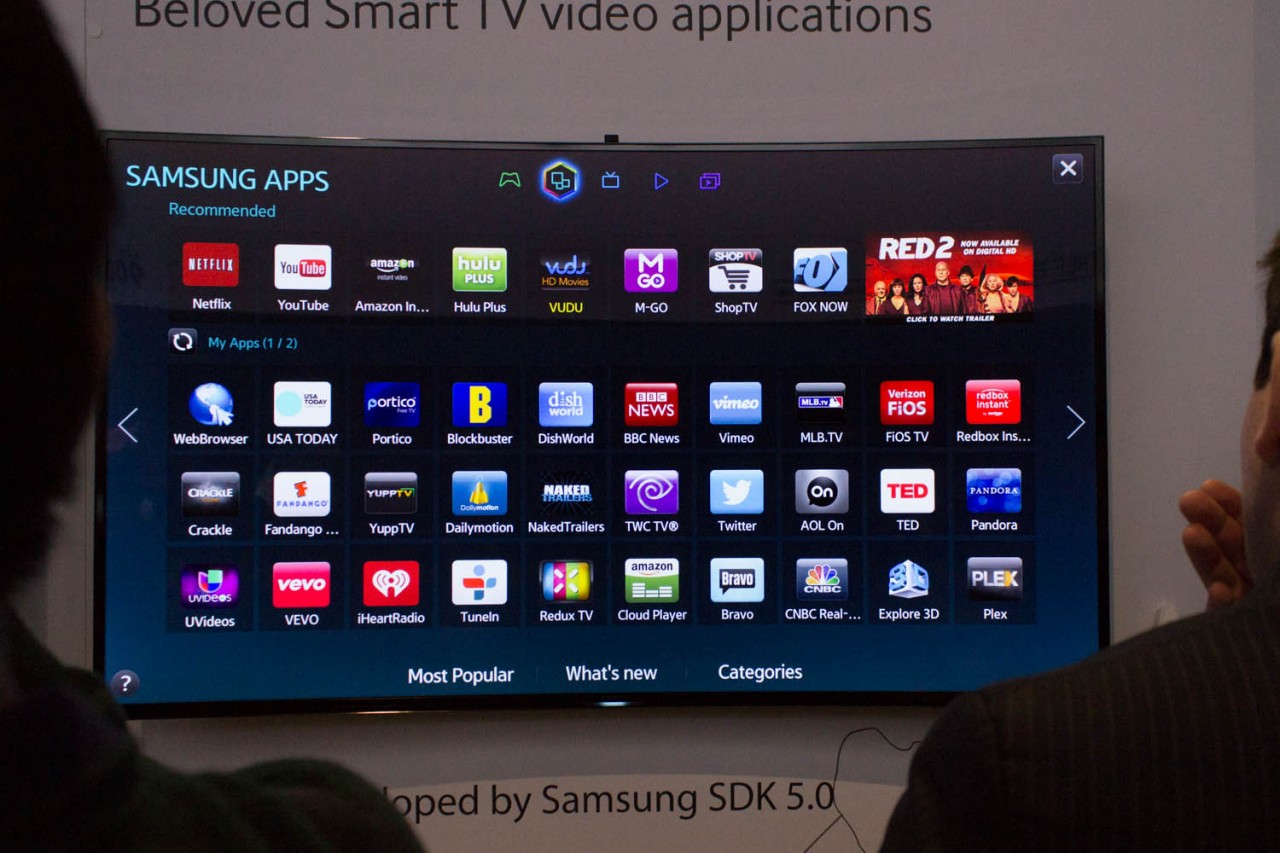
Enlarge / Samsung showed a curved 4K model last year, and this year decided to take them mainstream.
TCL writes that a typical flat screen “makes objects at the center seem larger,” but a curved TV “brings the edges closer to you,” creating a “theatrical effect.” The mixed argument of object proportionality and what theaters do aside, the statement that a flat screen would make centered objects seem larger seems to be at odds with the way video is filmed, the way we see things, and the way we are meant to see things in a film.
For instance, if we look at three chairs lined up in a row in front of us, of course the one at the center would seem larger because it’s literally closer. If we move the two chairs at the edge so they form a little semicircle, now everything looks proportional. But it’s a different scene, as the positioning is different. The chairs would now indeed seem to be surrounding us.

Enlarge / Even Konka is throwing a curved model out there.
If you tried to mimic the effect of chairs surrounding us by curving the picture of chairs in a line, maybe that conveys a different feeling. But it also fundamentally alters the truth of three chairs lined up in a row. The point is, an immersive feeling or feeling of being surrounded may be paramount for, say, a show on the deep ocean in an IMAX theater, but it's far from suited to every scene or situation.
This type of reality distortion wouldn’t be unprecedented, as filmmakers achieve effects like this by using different lenses. For instance, a fisheye lens creates the opposite effect that a curved TV theoretically does. Curved screens are also used in theaters to correct depth perception, and indeed, lots of manufacturers refer to curved screens as IMAX-like. We get the theory, but curved theater screens are not completely similar to the effect that curved TVs will give.
Per AnandTech, the minimum curvature of a curved theater screen has a radius of 40 feet. That’s a slight curve for a very large (30x70 foot) screen that's meant for people sitting many feet away. The curve of a Samsung OLED TV has a 13.7-foot radius, much tighter, for a much smaller screen and people sitting much closer. If a slight curve for a large screen at a large distance corrects an image, it seems like a tight curve on a small screen at a small distance would unnecessarily distort it a little.
The reasoning that came closest to a technical explanation of curved TVs came from Samsung’s booth, where we found some diagrams that claim a curved screen provides a more expansive field of view.
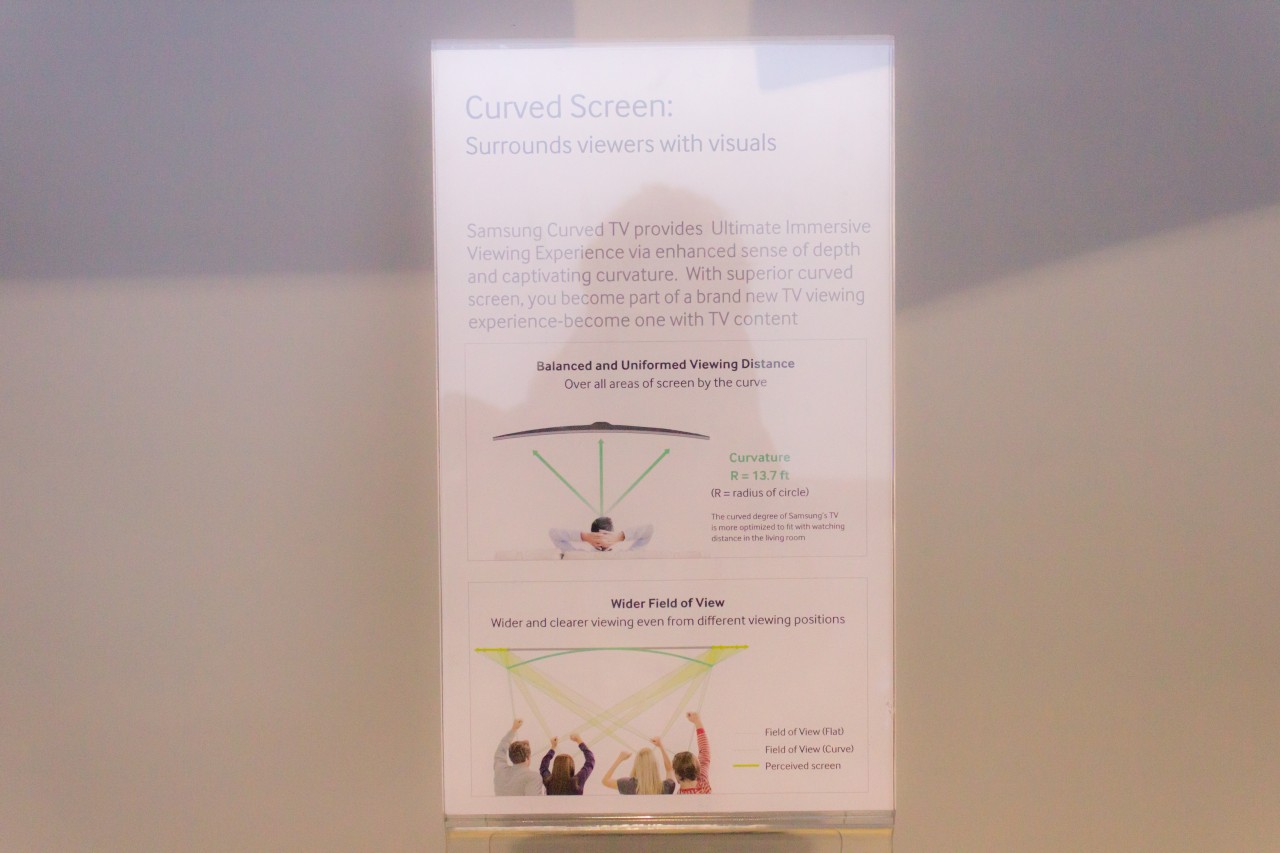
Enlarge / An explanatory diagram of how curved TV works. The first with arrows showing which way a person is looking when they are looking at a TV is great, but we will focus on the second.
A close read of this diagram also shows that, if we assume the TV being watched is 55 inches, the TV is about 50-inches wide. This means there are four people sitting within four feet of each other. Coziest loveseat ever. And how to solve this problem of cramped space? Buy a larger TV, of course.
Turning that screen width 90 degrees, we can also see these people are sitting all of three feet from the screen. Let’s scooch them back a bit.
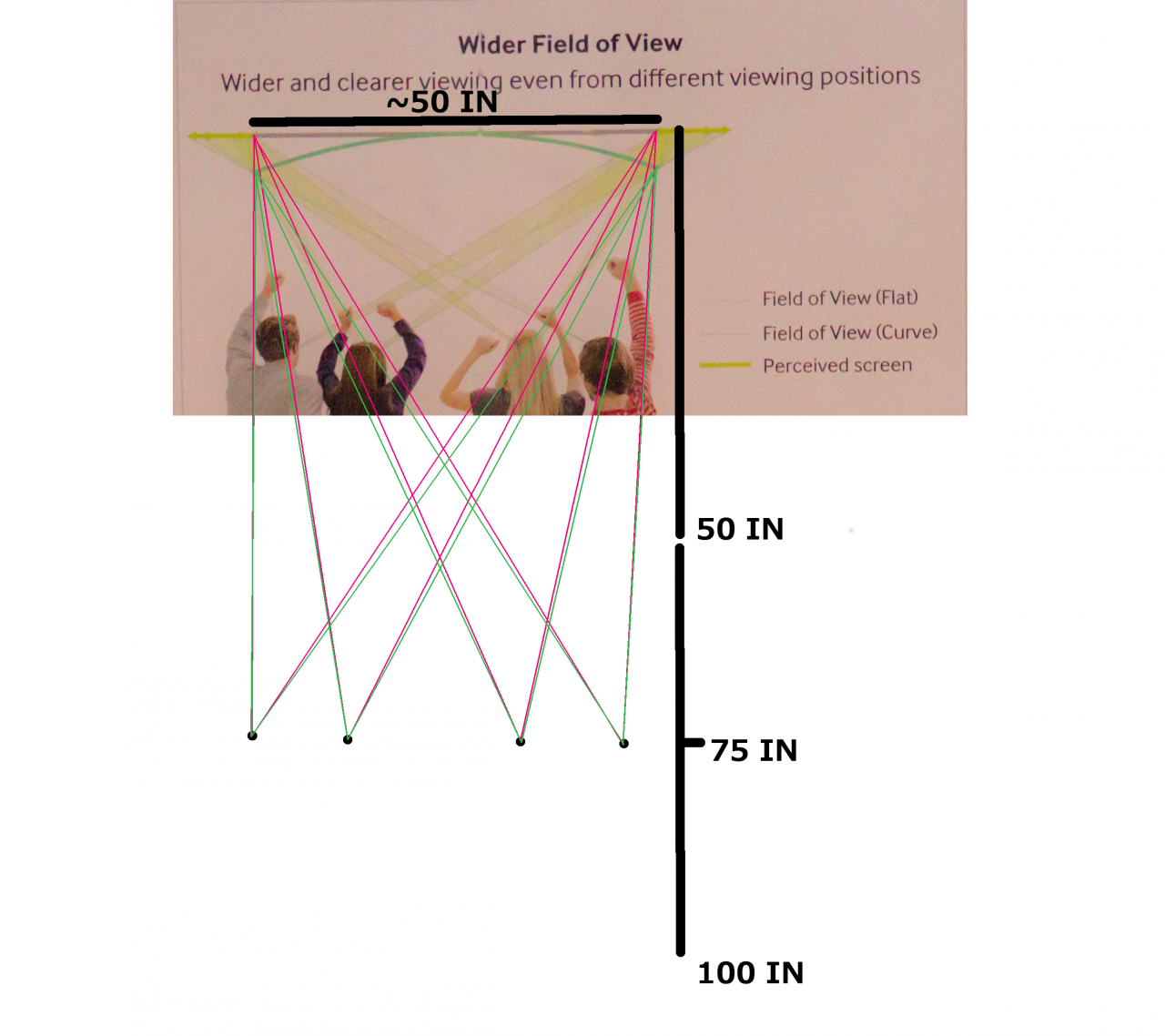
Enlarge / The field of view effects at a six-foot viewing distance. The envelopes between the green and pink lines show the "expansive" effect of a curved screen.
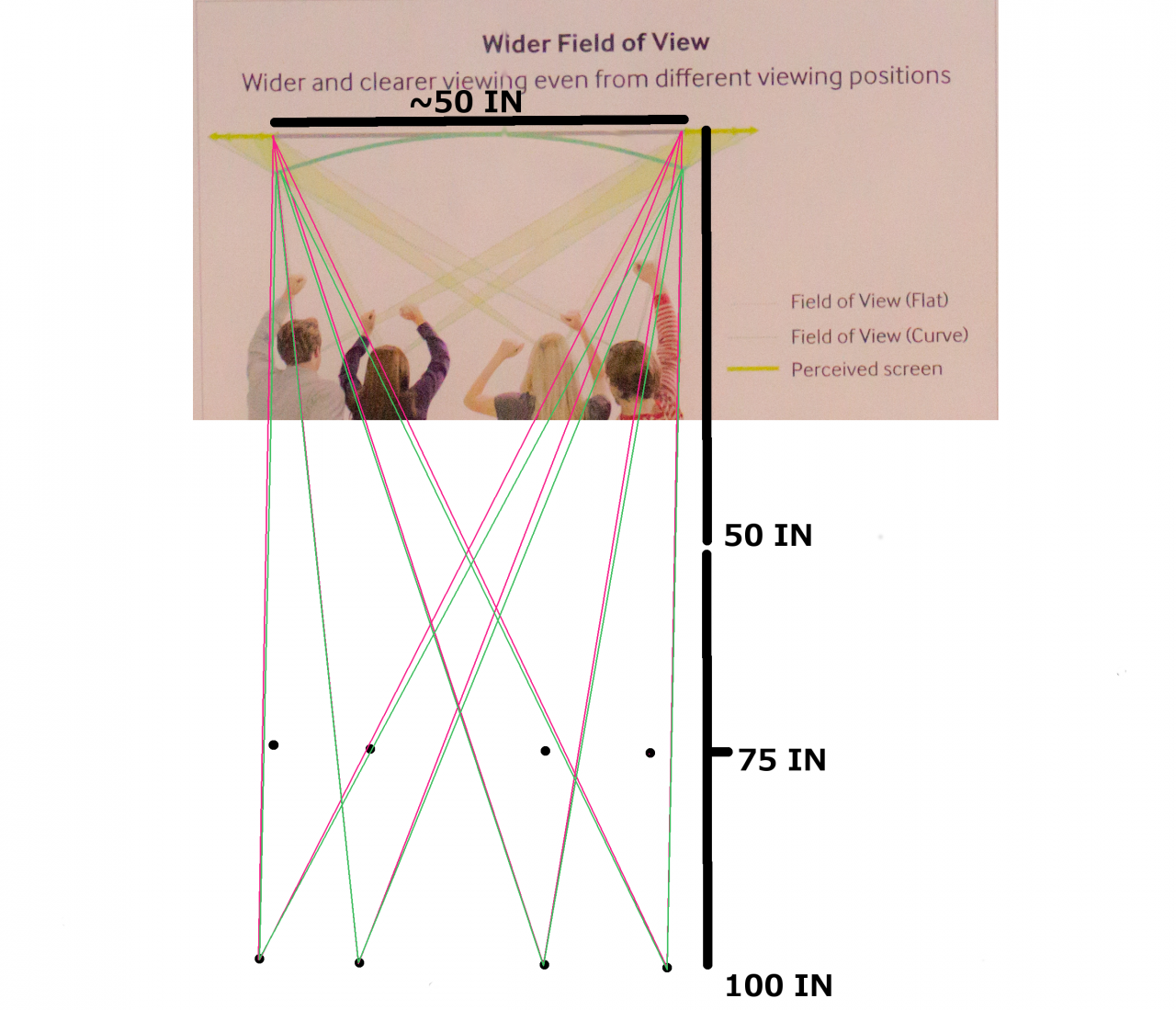
Enlarge / At eight feet, the benefits of a curved screen are quite small.
The curved screens seem most theatrical in the sense that, if your living room is not set up literally like a theater, people who are sitting off to the sides cannot benefit from the curve and will likely get a distorted picture. And at wider angles, the edges are cut off entirely.
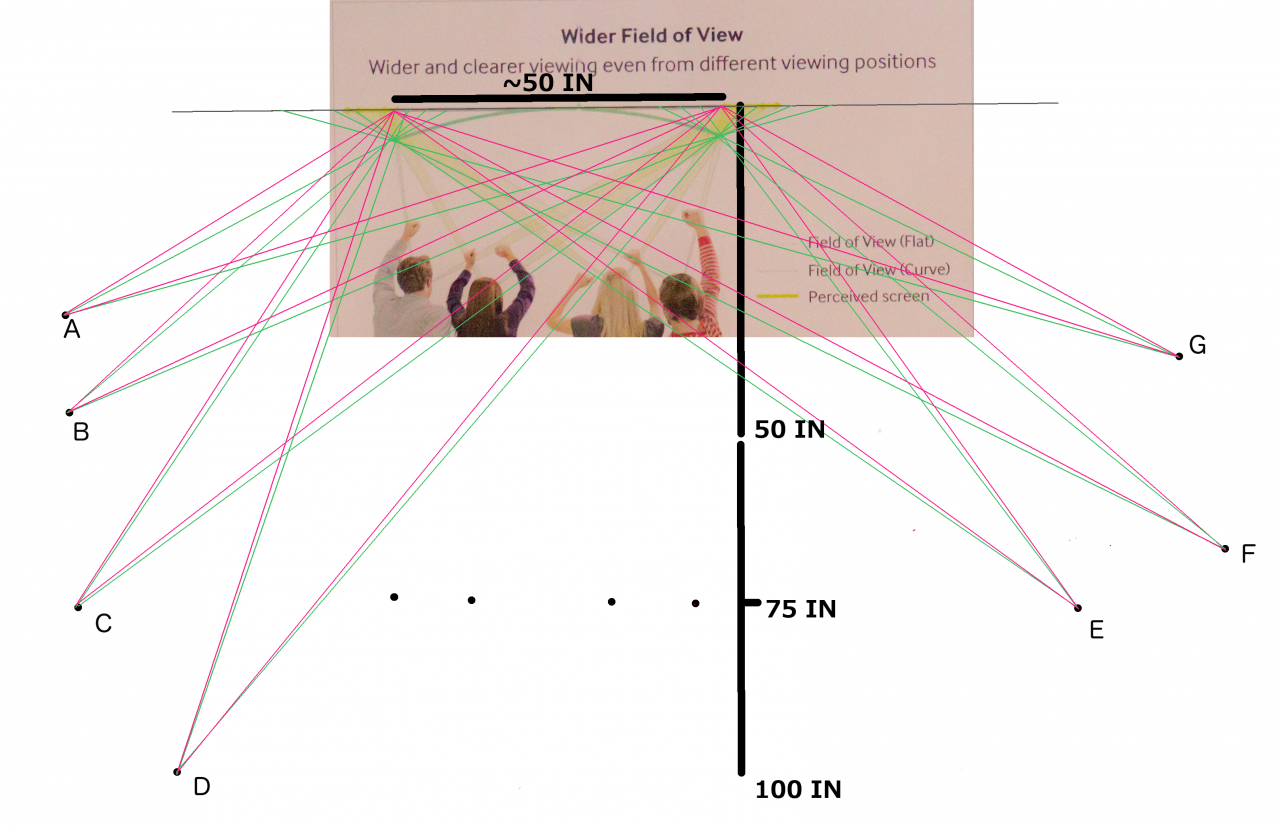
Enlarge / People sitting off-center don't get curved screen benefits, and they likely see a picture that is significantly more distorted than if the screen were flat.
If you started to fan viewers out beyond the edges of the TV, the picture for them would be distorted. Beyond a certain point, the image cuts off at one edge. These wide-seated viewers also don’t get the field-of-view benefits, as their envelope just shifts to one side or the other. Persons A and B can’t see the far left side of the screen, and G and F can’t see the right side. They would be able to see a flat screen TV, though the picture would be distorted. Even person D sitting at a slight angle loses all the “widened field of view” benefits of the curve.
Hence, a curved TV is only right for a very specific, pretty unusual setup: everyone right in front of the screen, very close to it. A Samsung rep speaking to TechRadar said that curved displays give “a greater range of viewing angles,” but from what we see here, that doesn’t seem to be the case.

Enlarge / If you use Samsung's diagram trick and scooch people closer to the screen, the field-of-view problems with off-center viewing are a little easier to see. A, B, E, and F are cut off from their sides of the screen.
Funnily enough, these diagrams show that, for certain setups, there actually is a point to the Samsung TV that can convert from flat to curved. When you are watching by yourself and can pull up a chair a few feet from the screen, go curve. When there are other people around whom you don’t want to sit practically in your lap, go flat.
Samsung also asserted in its PR presentations that the curved screens give video content a “3D-like effect,” but having the edges of a picture slightly closer doesn’t mimic any 3D experience we know of. Per the chair example above, the picture distortion would make you feel you are surrounded by chairs rather than looking at them. But as for things popping out of the screen, it doesn’t seem like curved TV will achieve that with its shape.
The mishmash of arguments for a curved TV isn’t necessarily an indictment of the value of curved TV. This would not be the first time that manufacturers obscured the technical or scientific reasons for a decision because they think it’s too hard to explain to consumers. It may be easier to latch onto words like “immersive” and “theatrical” and hope no one asks the hard questions.
But, it would also not be the first time that manufacturers assigned value to some spec based on the idea that it qualitatively improved a viewing experience in some way, only for consumers to find the end result is underwhelming and, more importantly, not worth paying for. Potentially over aggressive image distortion aside, is there a case for curved TV? Yes. Is it necessary, right for every setup, the way forward, or the new standard? No.
No comments:
Post a Comment